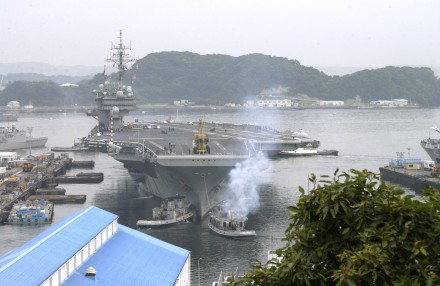
From J. Randy Forbes, the Diplomat: As Washington continues to debate the consequences of defense cuts, one line of popular thinking is that we can save tax dollars without sacrificing security if we close down our overseas bases and bring our forces home. Why do we still have bases in Europe? Shouldn’t the Japanese just defend themselves? . . .
Deterring regional aggression with forward basing has been central to U.S. military strategy since the end of World War II, when we resolved to never again have to “fight our way in” as we had just done in the Pacific. This strategy remains just as relevant today. Gen. Joseph Dunford, Assistant Commandant of the Marine Corps, recently testified that “being forward deployed and forward engaged allows us to shape the environment as opposed to reacting to the environment.” If a conflict with Iran were to erupt, or North and South Korea found themselves on the brink of war, or China threatened the use of force to acquire Taiwan, the robust regional presence of U.S. forces would have an immediate impact, either to deter escalation or quickly respond to aggression.
The United States’ forward presence also offers numerous diplomatic benefits. The politics of maintaining a presence in foreign nations no doubt comes with challenges. However, it also represents a steadfast commitment to an ally, which provides the basis for a sustained diplomatic partnership and regular military engagement and training with the host nation. For example, six decades of close cooperation between U.S. and Japanese naval forces have built an unrivaled degree of trust and interoperability. The presence of U.S. forces in South Korea has also helped to fashion a close relationship with the government in Seoul that would be vital during a crisis. And in Europe, U.S. forces have trained with NATO allies so that they have the capabilities to operate with us during an operation.
Despite these benefits, a number of myths about our overseas presence continue to promulgate. . . .
[C]ritics contend that the U.S. can sustain the same level of deterrence by maintaining sophisticated power-projection capabilities based on U.S. territory. But lost in this argument is the logistics required to overcome the tremendous “tyranny of distance” that separates the American homeland from these regional hotspots. Air Force F-15, F-16, and A-10 jets are inter-theater assets that aren’t designed to deploy across entire oceans. From Pearl Harbor, the Navy would have to sail 6,200 kilometers to Japan or 10,800 kilometers to the Strait of Malacca. The Marines would face an even greater hurdle if forced to deploy from the continental United States. Gen. Dunford testified that “it would take months to move (a force from the Continental United States) to the Western Pacific and seven consecutive miracles in terms of synchronizing the planes, trains and automobiles associated with moving that force.” Faced with these geographic hurdles, a continental-based military would be severely inhibited in its ability to credibly deter regional aggression and reassure American allies.
Rep. J. Randy Forbes, R-Va., is chairman of the House Armed Services Readiness Subcommittee and founder and co-chairman of the Congressional China Caucus. (photo: U.S Navy)
Image: usn%2012%205%2011%20Kitty-Hawk-440x286.jpg
